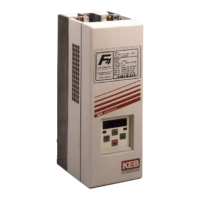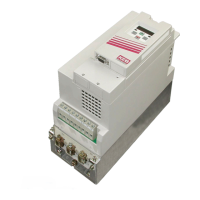88
7. Auswahl des Bremswiderstandes
Für den KEB COMBIVERT F3 stehen verschiedene Bremswider-
stände zur Verfügung, die je nach Einsatzfall dem Frequenzum-
richter zugeordnet werden.
Die entsprechenden Formeln und die Einschränkungen (Gültig-
keitsbereich) sind auf der nächsten Seite angegeben.
1. Gewünschte Bremszeit vorgeben.
2. Bremszeit ohne Bremsmodul berechnen ( t
Bmin
)
3. Wenn die gewünschte Bremszeit kleiner als die berechnete
Bremszeit ist, dann ist ein Bremsmodul erforderlich.
t
B
< t
Bmin
4. Bremsmoment berechnen ( M
B
)
Bei der Berechnung ist das Lastmoment zu berücksichtigen.
5. Spitzenbremsleistung berechnen ( P
B
)
Die Spitzenbremsleistung ist immer für den ungünstigsten Fall
( n
max
-> Stillstand ) zu berechnen.
6. Auswahl des Bremswiderstandes:
1. P
R
> P
B
2. P
N
ist entsprechend der Zykluszeit auszuwählen (ED).
Die Bremswiderstände dürfen nur für die aufgeführten Gerä-
tegrößen verwendet werden.
Die maximale Einschaltdauer des Bremswiderstandes und
des GTR 7 darf nicht überschritten werden (bei Auiftreten der
Spitzenbremsleistung).
6 - 8 % ED = maximale Einschaltzeit – 10 s
7. Überprüfen Sie, ob die gewünschte Bremszeit mit dem Brems-
modul erreicht wird ( t
Bmin
* ).
Einschränkung:
Das Bremsmoment darf, unter Berücksichtigung der Leistung
des Bremsmodules und der Bremsleistung des Motors, das
1,5fache Nennmoment des Motors nicht überschreiten ( siehe
Formeln ).
Der Frequenzumrichter ist bei Ausnutzung dieses maximal
möglichen Bremsmomentes auf den erhöhten Strom auszule-
gen.
7. Selection of Braking Resistor
Different braking resistors are available for KEB COMBIVERT F3.
Depending on the application the frequency inverter is fitted with
a suitable braking resistor.
You find the appropriate formulas and the restrictions (validity
range) on the next page.
1. Set the desired braking time
2. Calculate the braking time without braking module ( t
Bmin
)
3. If your desired braking time is shorter than the calculated
braking time it is necessary to use a braking module.
t
B
< t
Bmin
4. Calculate the braking torque ( M
B
)
For this calculation the load torque must be taken into
consideration.
5. Calculate the peak braking power ( P
B
)
Always calculate the peak braking power for the worst situation
( n
max
-> standstill ).
6. Selection of braking resistor:
1. P
R
> P
B
2. P
N
is to be selected in accordance to the duty cycle (ED).
The braking resistors may be used only for the listed inverter
sizes.
The maximum cyclic duration factor of the braking resistor and
the GTR 7 must not be exceeded (during peak braking voltage).
6 - 8 % cyclic duration factor = maximum switch-on time – 20 s
7. Please check whether braking module attains the desired bra-
king time ( t
Bmin
* ).
Restriction:
Considering the power of the braking module and the braking
power of the motor, the braking torque must not exceed 1.5-
times rated torque of the motor (see formulas).
To utilize the maximum possible braking torque the frequency
inverter must be dimensioned for the increased current.

